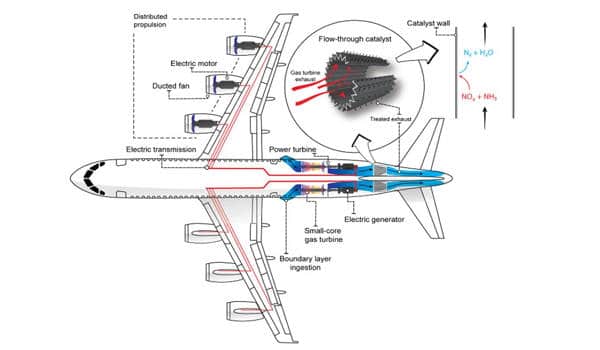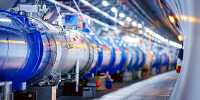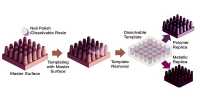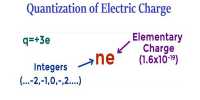According to engineers, a proposed hybrid-electric plane could ‘eliminate aviation’s air pollution problem.’ According to a study, the new design could reduce global nitrogen oxide (NOx) emissions by 95%.
Airplanes emit a steady stream of nitrogen oxides into the atmosphere at cruising altitude, where the chemicals can linger and produce ozone and fine particulates. NOx, or nitrogen oxides, are a major source of air pollution and have been linked to asthma, respiratory disease, and cardiovascular disease. Previous research has found that the production of these chemicals as a result of global aviation causes 16,000 premature deaths each year.
MIT engineers have developed a concept for airplane propulsion that they estimate would eliminate 95 percent of aviation’s NOx emissions and, as a result, reduce the number of associated premature deaths by 92 percent.
The idea is based on emissions-control systems found in ground transportation vehicles. Many heavy-duty diesel trucks now include post-combustion emissions-control systems to reduce NOx emissions from engines. The researchers now propose an electric version of a similar design for aviation.
A proposed hybrid-electric plane could ‘eliminate aviation’s air pollution problem,’ say, engineers. The new design could reduce global nitrogen oxide (NOx) emissions by 95 percent, they report in a study.
Jet engines are anchored beneath each wing of today’s planes. Each engine houses a gas turbine that powers a propeller that propels the plane through the air as exhaust from the turbine exits the back. Because of this configuration, emissions-control devices could not be used because they would interfere with the thrust produced by the engines.
The source of power for a plane in the new hybrid-electric, or “turbo-electric,” design would still be a conventional gas turbine, but it would be integrated within the plane’s cargo hold. Rather than directly powering propellers or fans, the gas turbine would drive a generator, also located in the hold, to generate electricity, which would then be used to power the plane’s wing-mounted, electrically driven propellers or fans. The gas turbine’s emissions would be fed into an emissions-control system, similar to those found in diesel vehicles, which would clean the exhaust before ejecting it into the atmosphere.
“This would still be a tremendous engineering challenge,” says Steven Barrett, an MIT professor of aeronautics and astronautics. “If you want to get to a net-zero aviation sector, this is a potentially significant way of solving the air pollution part of it in a technologically feasible way.”
The design details, including analyses of potential fuel costs and health effects, were published today in the journal Energy and Environmental Science. Prakash Prashanth, Raymond Speth, Sebastian Eastham, and Jayant Sabnins, all of whom work at MIT’s Laboratory for Aviation and the Environment, are the paper’s co-authors.

A semi-electrified plan
Barrett and his team’s work investigating the Volkswagen diesel emissions scandal sowed the seeds for the team’s hybrid-electric plane. Environmental regulators discovered in 2015 that the car manufacturer had intentionally manipulated diesel engines to activate onboard emissions-control systems only during lab testing, causing them to appear to meet NOx emissions standards but emit up to 40 times more NOx in real-world driving conditions.
Barrett became acquainted with diesel vehicles’ emissions-control systems in general as he investigated the health consequences of emissions cheating. At the same time, he was investigating the possibility of developing large, all-electric aircraft.
“Research done in the last few years shows that you could probably electrify smaller aircraft,” Barrett says, “but for big aircraft, it won’t happen anytime soon without pretty major breakthroughs in battery technology.” “So I thought, maybe we can take the electric propulsion part from electric planes and the gas turbines that have been around for a long time and are super reliable and very efficient, and combine that with the emissions-control technology that is used in automotive and ground power, to at least enable semielectrified planes.”
Flying with zero impact
Before airplane electrification was seriously considered, a concept like this could have been implemented, for example, as an add-on to the back of jet engines. However, as Barrett points out, this design would “kill any stream of thrust” produced by a jet engine, effectively rendering the design obsolete.
Barrett’s design overcomes this limitation by separating the thrust-generating propellers or fans from the power-generating gas turbine. Instead, the propellers or fans would be powered directly by an electric generator, which in turn would be powered by the gas turbine. The exhaust from the gas turbine would be routed through an emissions-control system that could be folded up accordion-style in the plane’s cargo hold, completely isolated from the thrust-producing propellers.
He envisions the majority of the hybrid-electric system, including the gas turbine, electric generator, and emissions control system, fitting within the belly of a plane, where there is usually plenty of room in many commercial aircraft.
According to the researchers’ new paper, if such a hybrid-electric system were installed on a Boeing 737 or Airbus A320-like aircraft, the extra weight would necessitate about 0.6 percent more fuel to fly the plane.
“This is far more feasible than what has been proposed for all-electric aircraft,” Barrett says. “This design would add hundreds of kilograms to a plane, as opposed to adding many tons of batteries, which would be a factor of ten.”
The researchers also calculated the emissions produced by a large aircraft with and without an emissions control system and discovered that the hybrid-electric design would eliminate 95% of NOx emissions.
If this system were implemented on all aircraft worldwide, they estimate that 92 percent of pollution-related deaths caused by aviation would be avoided. They arrived at this estimate by mapping the flow of aviation emissions through the atmosphere with a global model and calculating how much different populations around the world would be exposed to these emissions. These exposures were then converted to mortalities or estimates of the number of people who would die as a result of exposure to aviation emissions.
The team is currently developing designs for a “zero-impact” airplane that will fly without emitting NOx or other chemicals such as climate-altering carbon dioxide. “We need to get to essentially zero net-climate impacts and zero air pollution deaths,” Barrett says. “The current design would effectively eliminate the problem of aviation air pollution. We’re currently working on the climate impact aspect of it.”















